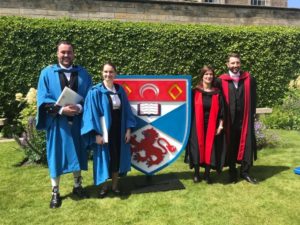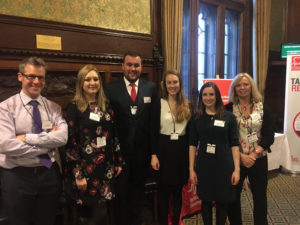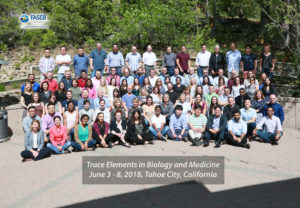The Pitt and Stewart labs would like to say a big congratulations to Dr Gavin Robertson and Dr Amelie Sobczak on their graduation, and would also like to say a big thank you to the BHF for funding these students. #Ever to Excel
 sjp24
sjp24
Samantha Pitt has been elected as a board member of the International Society for Zinc Biology
Dr Samantha Pitt has been elected as a board member of the International Society for Zinc Biology (http://iszb.org/). She will serve the Society for 2 years. She is very excited to contribute towards the future direction of the Society and will work to raise the awareness of the scientific community regarding the importance of zinc in health and disease.
Congratulations to Gavin Robertson on passing his PhD viva!
The Metal Ions in Medicine group would like to say a big congratulations to Gavin Robertson on passing his PhD viva.
Zinc-net meeting – 18th January 2019. Anglia Ruskin University, Cambridge, UK
The Metal Ions in Medicine team attended the 2019 Zinc-net meeting in Cambridge, UK. This International meeting focused on investigating the role of zinc in biological systems. Dr Samantha Pitt gave the opening plenary lecture. The title of her talk was “Altered Zn2+ homeostasis in Niemann-Pick C1 disease results in impaired NAADP-mediated lysosomal Ca2+-dynamics”. Dr Alan Stewart gave a talk titled “Influence of free fatty acids on plasma zinc handling by albumin: Impact on coagulation in type II diabetes”. Gavin Robertson (BHF funded PhD student in the Pitt lab) presented a poster titled “Mitsugumin 23: a cardiac sarcoplasmic reticulum Ca2+ leak channel that displays Zn2+ permeability”.
The team would like to thank Dr Nick Pugh (Anglia Ruskin University) for organising this meeting.
Dundee Science Festival 2018
 Amy Dorward (Pitt Research group) took part in the Dundee Science festival 7th October 2018. She volunteered at the British Heart Foundation’s “Air Street”. The exhibit focussed on the silent harmful effects air pollution has on the cardiovascular system. Visitors walked ‘outside’ along “BHF Air Street” – where posters outlined the main links of pollution and cardiovascular disease – before coming ‘inside’ to the “BHF sitting room” – where they learned more about the research being carried out by the BHF in their local area. Visitors were also given the opportunity to look at diseased and healthy heart cell cells under the microscope, measure their own heart rates and learn about how the heart works through a variety of activities. Amy really enjoyed volunteering at the festival and she is grateful to have had the opportunity to talk about some of the cardiovascular research being carried out in University of St Andrews.
Amy Dorward (Pitt Research group) took part in the Dundee Science festival 7th October 2018. She volunteered at the British Heart Foundation’s “Air Street”. The exhibit focussed on the silent harmful effects air pollution has on the cardiovascular system. Visitors walked ‘outside’ along “BHF Air Street” – where posters outlined the main links of pollution and cardiovascular disease – before coming ‘inside’ to the “BHF sitting room” – where they learned more about the research being carried out by the BHF in their local area. Visitors were also given the opportunity to look at diseased and healthy heart cell cells under the microscope, measure their own heart rates and learn about how the heart works through a variety of activities. Amy really enjoyed volunteering at the festival and she is grateful to have had the opportunity to talk about some of the cardiovascular research being carried out in University of St Andrews.
Congratulations Ben Reilly-O’Donnell on passing your PhD viva
The Pitt lab would like to say a big congratulations to Ben Reilly-O’Donnell who passed his PhD viva today. Ben did very well and we are all incredibly proud of him.
Ben has recently started a new position as a postdoctoral research scientist working with Prof. Julia Gorelik, Faculty of Medicine, National Heart & Lung Institute, Imperial College London
Trace Elements in Biology and Medicine 2018 – Federation of American Societies for Experimental Biology
The FASEB – Trace Elements in Biology and Medicine meeting 2018 took place in Tahoe City, California, USA 3-8 June. Samantha Pitt would like to thank Dr Amanda Bird (Ohio State University) and Dr Paul Cobine (Auburn University) for putting together such an exciting programme. Samantha would also like to thank the organisers for inviting her to present her work. The title of her talk was “Cardiac dysfunction and the role of zinc in sarcoplasmic reticulum remodelling”
BHF Parliamentary Reception at Westminster – Gavin Robertson BHF funded PhD Student attends
On Wednesday 22nd November, 3rd year PhD student Gavin Robertson was invited to attend a British Heart Foundation Parliamentary reception at Westminster. The event was held in the Members’ dining room of the Houses of Parliament and was sponsored by Chris Green MP. This provided a great opportunity to promote our BHF-funded work in St. Andrews to MPs and fellow BHF researchers.
Dundee Science Festival 2017 – Our BHF funded students talk about heart and circulatory disease
Our British Heart Foundation funded students Gavin Robertson, Amy Dorward (Pitt lab) and Amelie Sobczak (Stewart lab) took part in the 2017 Dundee Science festival hosted by the BHF. They volunteered at the BHFs family-orientated interactive pop-up lab “what’s it like to be a heart scientist?” Here they educated visitors on how the heart works, what can go wrong in heart disease, and the importance of looking after your heart. The event was a fun and interactive way to engage children into the world of medical research, as well as conveying information to adults about the vital work and research that the BHF carries out locally. They found the event to be very enjoyable and hope that it will inspire future heart research scientists.
Amy Dorward starts her BHF funded PhD Studentship today
The Pitt lab would like to welcome Amy Dorward to the group. Amy starts her 3 year BHF funded PhD studentship today. Amy will be looking at how zinc shapes calcium dynamics in ischaemic heart failure.


